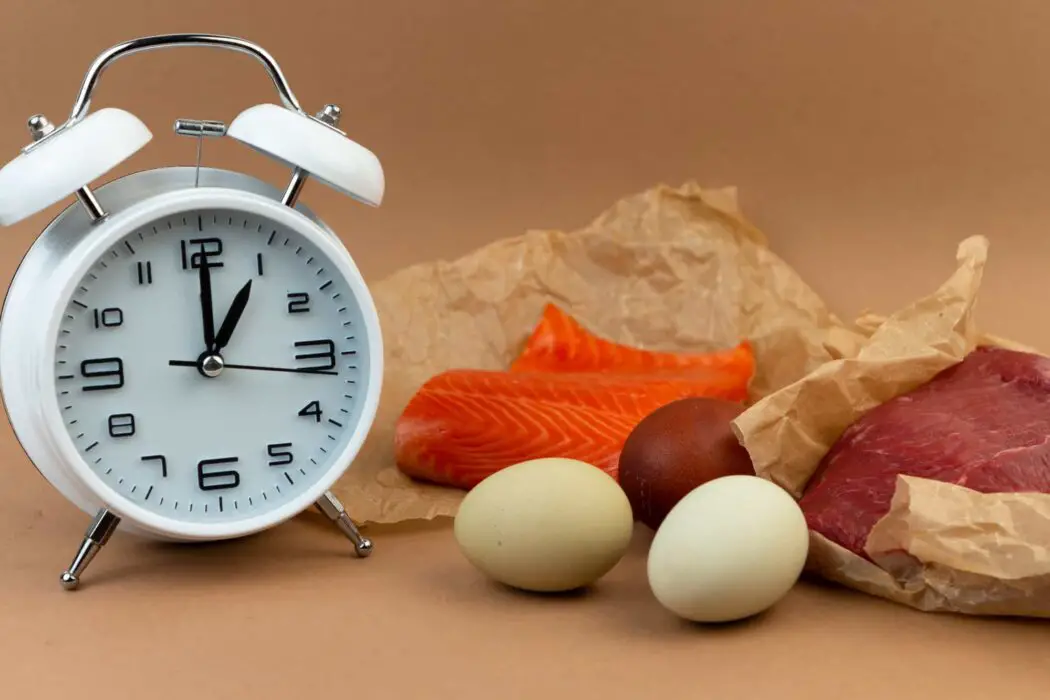Intermittent fasting 14/10 is an excellent opportunity to effortlessly lose a few extra pounds. This diet plan is suitable for those who find it challenging to keep longer periods without food, such as intermittent fasting 16/8 or 20/4. Fasting for 14 hours does not require much effort from you, but nevertheless has its benefits for healthy weight loss. You no longer need to stick to exhausting diets and constantly experience an acute feeling of hunger. Losing weight has never been so easy!
What is the difference between the types of intermittent fasting? How to follow 14/10 intermittent fasting, and what are its basic rules? Are there any benefits to this type of fasting? I will tell you all the details in this article. Keep reading our intermittent fasting guide to find out more!

What Is Intermittent Fasting?
Many diets are based on the rejection of certain foods, limiting the intake of nutrients essential for health. Counting calories, tormenting yourself in the gym, and depriving yourself of your favorite foods puts your brain under constant stress. As a result, you get gastritis, depression, and decreased immunity in pursuit of a fit body. In addition, strict diets are challenging to follow for a long time without harming health. Doctors have long talked about the dangers of diets and the benefits of a balanced diet combined with adequate physical activity.
Intermittent fasting is not a diet but rather a healthy lifestyle option that can be followed for a long time, literally all your life. Various studies have repeatedly proven its effectiveness for weight loss, and additional bonuses are health, youth, and active longevity due to the activation of the autophagy process.
Intermittent fasting means avoiding food during certain hours of the day, while the rest of the time, you can eat whatever you want. There are many different options for intermittent fasting – simple and complex, which differ in fasting intervals and meals. All these options have their advantages, and you will easily find the one that suits you best.
Main Rules of the Intermittent Fasting 14/10
So how to do intermittent fasting? Fasting for 14 hours is one of the easiest options, as it gives you a fairly wide eating window of 10 hours. In fact, this is the well-known formula “do not eat before bed.” This eating plan is in tune with your circadian rhythm, making it easy for you to shed extra pounds without harming your health.
This diet plan implies the main meal in the morning, and the last one should be light and not late. After a hearty and rich breakfast, intestinal motility is activated, and gastric juice is secreted. Proteins, fats, and carbohydrates are broken down as much as possible to give the necessary energy to the body, which is properly consumed and not stored in fat. Your dinner should be at least 4 hours before bed and consist of foods with a low glycemic index. This type of nutrition contributes to weight loss and weight maintenance in people with an average body mass index, normalizes sleep, and improves overall health characteristics. [1]
If you don’t like breakfast, you can start your afternoon meal with a brunch (around 11 a.m.) and end with a late dinner around 9 p.m. However, in this case, your dinner should be light and not contain complex carbohydrates in order not to overload your digestive system before bed. In any case, your task is to eat for 10 hours and abstain from food for 14 hours. It is not difficult because we spend 8-9 hours in bed.
 How Does Intermittent Fasting Work?
How Does Intermittent Fasting Work?
Once in the body, food is broken down and eventually converted into molecules. Carbohydrates (mainly sugar, bread, rice, and other complex carbohydrates) are quickly converted into glucose, which cells use for energy. Then your body stores excess glucose in body fat. The hormone insulin directs these processes and is also responsible for keeping glucose in the cells.
As soon as you start eating, blood insulin rises and falls between meals, so body fat can release stored sugar to use as missing energy. By lowering insulin levels, you help the body burn fat on its own and lose weight. It is the principle of intermittent fasting.
Intermittent fasting 14/10 is one of the most accessible options that doesn’t actually make you feel hungry for a long time and allows you to burn excess body fat effortlessly. [2] It helps in maintaining a good physical shape and a healthy weight. When switching to fasting mode, the body starts the process of breaking fat instead of glucose. This natural mechanism has allowed our ancestors to survive in the absence of food and still helps us to get rid of the consequences of overeating.
What Are the Benefits of Intermittent Fasting 14/10?
Even with a relatively short fasting period of about 14 hours, the process of autophagy is enhanced – getting rid of damaged and dead cells and their particles. In combination with increased production of growth hormone (especially active during sleep), which is also considered to be the effect of fasting, it provides a powerful stimulus for cell renewal.
Intermittent fasting 14/10 has a hugely positive effect on blood sugar levels – this is especially true for people who have metabolic disorders, including those with type II diabetes. [3] However, remember that you should not practice fasting when insulin-dependent.
During Intermittent fasting 14/10, the insulin level normalizes, restoring the sensitivity of cells to insulin and leptin, the hormone responsible for regulating appetite and signals about hunger or satiety. Resistance is a sign of metabolic syndrome – a metabolic disorder that leads to various health problems and contributes to the rapid growth of visceral fat. Unlike subcutaneous fatty tissue, it is deposited on the internal organs in the abdomen. It increases the risk of cardiovascular and endocrinological diseases. Getting rid of visceral fat with a regular diet is quite difficult. However, intermittent fasting hours reduce its amount quite successfully. [4]
For people who suffer from digestive problems due to lazy bowel syndrome or an unhealthy intestinal microbiome, fasting can help improve the situation significantly. [5] During fasting, inflammatory processes reduce (and this, by the way, applies not only to the digestive system) while fermentation processes slow down. Some experts argue that this is the perfect time to take probiotics to achieve the maximum effect in the shortest possible time.
 In addition, intermittent fasting 14/10 is considered a good tool for normalizing blood pressure, lowering the level of “bad” cholesterol in the blood (called low-density lipoprotein), improving cognitive abilities, and even enhancing the effect of chemotherapy. You can feel lighter and more cheerful. It is easier for you to focus on work and important matters, easier to endure stressful situations [6], to fall asleep in the evening and wake up in the morning.
In addition, intermittent fasting 14/10 is considered a good tool for normalizing blood pressure, lowering the level of “bad” cholesterol in the blood (called low-density lipoprotein), improving cognitive abilities, and even enhancing the effect of chemotherapy. You can feel lighter and more cheerful. It is easier for you to focus on work and important matters, easier to endure stressful situations [6], to fall asleep in the evening and wake up in the morning.
What to Eat for a Healthy Weight Loss?
To easily lose a couple of extra pounds with 14/10 intermittent fasting, you just need to observe a complete fast during the hungry period. However, you will achieve the best results if you follow several fasting rules and choose healthy food with a balance of nutrients on your menu. So let’s talk about intermittent fasting – what to eat and what to avoid. [7]
Dairy and Animal Protein
Proteins are the key macronutrient. The main elements of proteins, amino acids, are part of muscle tissue and DNA. That is why essential amino acids are an example of vital nutrients, the absence of which quickly and negatively affect metabolism.
Proteins are necessary for cell growth and body repair, and they give a feeling of long satiety. High-quality, healthy protein is found in fish, seafood, eggs, milk, animal and poultry meat, tofu, and plant foods (in legumes, nuts, chia, or quinoa seeds).
Vegetables and Fruits
Formally, fiber belongs to the class of complex carbohydrates. However, it is not digested by the stomach and does not take an active part in the metabolism. Despite this, the presence of this nutrient in the diet is necessary both for the mechanical processes of digestion and for maintaining normal blood sugar levels.
Fiber is found only in plant foods – primarily in vegetables, fruits, and cereals. Some seeds (for example, chia seeds) contain soluble fiber that can absorb moisture like a sponge. Such dietary fiber becomes a prebiotic food for beneficial bacteria in the stomach.
 Healthy Fats
Healthy Fats
Although fatty foods are traditionally considered unhealthy, cutting out fat completely is dangerous to health. For example, the body needs saturated fatty acids to produce testosterone. Also, excluding fat from the diet can disrupt the brain since most of its weight falls on fat.
Of particular importance is what kind of fatty acids you consume. For example, Omega-3 fatty acids reduce the number of micro-inflammations. However, at the same time, Omega-6 (found in sunflower and corn oil) increases such inflammations.
On the other hand, another component of fats – cholesterol, refers to micronutrients. Only a small amount of this substance is sufficient for metabolism. Besides, the body produces a significant part of cholesterol on its own.
Plenty of Water
Keep hydrated for whole-body health. Water plays an important role in the transport of nutrients in the body’s cells, eliminates accumulated toxins, and helps the body perform various functions. It also regulates body temperature, plays the role of lubrication, and protects the joints from excessive stress. The deficiency of water in the body leads to dehydration, lack of energy, and fatigue. During fasting, you can drink clean water without restriction, as well as tea and moderate amounts of coffee without any additives.
Daily Calorie Value
In the distribution of macronutrient proportions, the key role is played by the daily calorie intake required by a particular person. It is affected by both the level of a person’s physical activity during the day and basal metabolic rate (the energy needed by the body and brain to sustain life activities).
In fact, the calculation of nutrients begins with determining daily calorie requirements. [8] If you follow a classic mixed diet, then about half of this amount should come from carbohydrates, a third from proteins, and the rest from fats. In turn, athletes for muscle growth need more energy from proteins, and when dieting for weight loss, you need to cut carbs.
What Foods to Avoid During 14/10 Intermittent Fasting?
You should avoid certain foods during any diet and healthy lifestyle plan, and 14/10 intermittent fasting is no exception. In general, there are two categories of unhealthy foods that you should avoid for weight loss and full-body health.
Saturated and Trans Fats
These are fats that contain trans-isomers of unsaturated fatty acids. Trans fats can be found in small amounts in natural foods (in milk and meat, as well as in vegetable oils). Still, trans fats manufactured industrially and added to various foods bring the greatest danger. [9]
Industrially produced trans fats are solid fats obtained from liquid vegetable oils by hydrogenation (hydrogen addition). The hydrogenation (hardening) procedure significantly increases the shelf life of fats, which is very beneficial for manufacturers of various foods. And if most vegetable oils are very useful for the human body, then after the hydrogenation process, the chemical composition of the oil changes greatly and becomes dangerous for you.
It is worth noting that most vegetable oils (sunflower, olive, soybean, corn, etc.) also become a source of trans fats when frying. For this reason, doctors and nutritionists strongly recommend minimizing fried foods and even completely eliminating them from the diet. Instead, you can use healthy oils for cooking in the oven or sautéing to reduce your saturated and trans fats intake.
Excess Sugar and Refined Carbs
Refined carbohydrates are easily digestible carbohydrates with a high glycemic index. They often have a simple structure and consist of one or two molecules – for example, fructose, glucose, and lactose. They are highly soluble in water and have a sweet taste. Fast carbohydrates also include foods with a complex molecular structure but a high absorption rate. The list of such foods includes white rice and flour – the calories contained in them are absorbed by the body as quickly as calories from simple carbohydrates.
In general, the main example of fast carbohydrates is sugar (an equivalent mixture of glucose and fructose) – any food in which it acts as the main ingredient has a high glycemic index and is absorbed as quickly and easily as possible. It is all food that contains sugar and its analogs – from refined sugar and coconut sugar to jam, honey, sweet fruits, and most white flour foods (bread, pasta, and sweet pastries). Any sweets are 70-80% fast carbohydrates.
Unlike complex carbs and fiber, fast carbs only take a few minutes to be converted into blood sugar, give you a burst of energy and cause insulin levels to rise, increasing your risk of diabetes and obesity.

Healthy Tips for Successful Fasting
Researches on intermittent fasting 14/10 and the eating window often contradict typical dietitian recommendations (for example, calling into question the benefits of frequent small meals).
Many of the statements are still only theories that do not have a clear evidence base. However, the basic recommendations can be summarized in the following points:
- Do not eat after dinner – apparently, even small amounts of carbohydrates can provoke a significant metabolic response in the evening.
- Don’t eat in the early hours after waking up – there is a belief that the body needs time to switch to digestion mode in the morning.
- Stick to a regular diet – try to eat at about the same time, which will allow the body to adapt to metabolic cycles.
- How long should you do intermittent fasting? Stick to the selected option for a long time – it probably takes the body up to several weeks to adjust to a particular eating schedule.
Conclusion
Intermittent fasting 14/10 triggers autophagy mechanisms and retains all the beneficial effects of fasting. It normalizes weight, reduces sugar and cholesterol, slows down the aging process, and reduces the risk of various diseases. At the same time, you physically and psychologically do not experience significant suffering since, in the eating window, you can eat almost everything you want. And, unlike strict diets, intermittent fasting can be observed for a very long time without harming health.
Breaks between meals depend on the individual characteristics of a person. However, 14/10 fasting is a very simple lazy option. It does not restrict your eating for long periods while maintaining a comfortable nutrition and fasting schedule.
Sources:
- Ganesan K, Habboush Y, Sultan S. Intermittent Fasting: The Choice for a Healthier Lifestyle. Cureus. 2018;10(7):e2947. Published 2018 Jul 9. doi:10.7759/cureus.2947Rynders CA, Thomas EA, Zaman A, Pan Z, Catenacci VA, Melanson EL. Effectiveness of Intermittent Fasting and Time-Restricted Feeding Compared to Continuous Energy Restriction for Weight Loss. Nutrients. 2019;11(10):2442. Published 2019 Oct 14. doi:10.3390/nu11102442
- Rajpal A, Ismail-Beigi F. Intermittent fasting and ‘metabolic switch’: Effects on metabolic syndrome, prediabetes, and type 2 diabetes. Diabetes Obes Metab. 2020 Sep;22(9):1496-1510. doi:10.1111/dom.14080. Epub 2020 Jun 3. PMID: 32372521.
- Patterson, R. E., Laughlin, G. A., LaCroix, A. Z., Hartman, S. J., Natarajan, L., Senger, C. M., Martínez, M. E., Villaseñor, A., Sears, D. D., Marinac, C. R., & Gallo, L. C. (2015). Intermittent Fasting and Human Metabolic Health. Journal of the Academy of Nutrition and Dietetics, 115(8), 1203–1212. doi.org/10.1016/j.jand.2015.02.018
- Guo Y, Luo S, Ye Y, Yin S, Fan J, Xia M. Intermittent Fasting Improves Cardiometabolic Risk Factors and Alters Gut Microbiota in Metabolic Syndrome Patients. J Clin Endocrinol Metab. 2021 Jan 1;106(1):64-79. doi:10.1210/client/dgaa644. PMID: 33017844.
- Welton S, Minty R, O’Driscoll T, Willms H, Poirier D, Madden S, Kelly L. Intermittent fasting and weight loss: Systematic review. Can Fam Physician. 2020 Feb;66(2):117-125. PMID: 32060194; PMCID: PMC7021351
- Skerrett PJ, Willett WC. Essentials of healthy eating: a guide. J Midwifery Women’s Health. 2010;55(6):492-501. doi:10.1016/j.jmwh.2010.06.019
- Dragon E, Pomatto-Watson LCDD, Bernier M, Price NL, de Cabo R. Intermittent fasting: from calories to time restriction. Geroscience. 2021;43(3):1083-1092. doi:10.1007/s11357-021-00335-z
- Dhaka V, Gulia N, Ahlawat KS, Khatkar BS. Trans fats-sources, health risks and alternative approach – A review. J Food Sci Technol. 2011;48(5):534-541. doi:10.1007/s13197-010-0225-8
